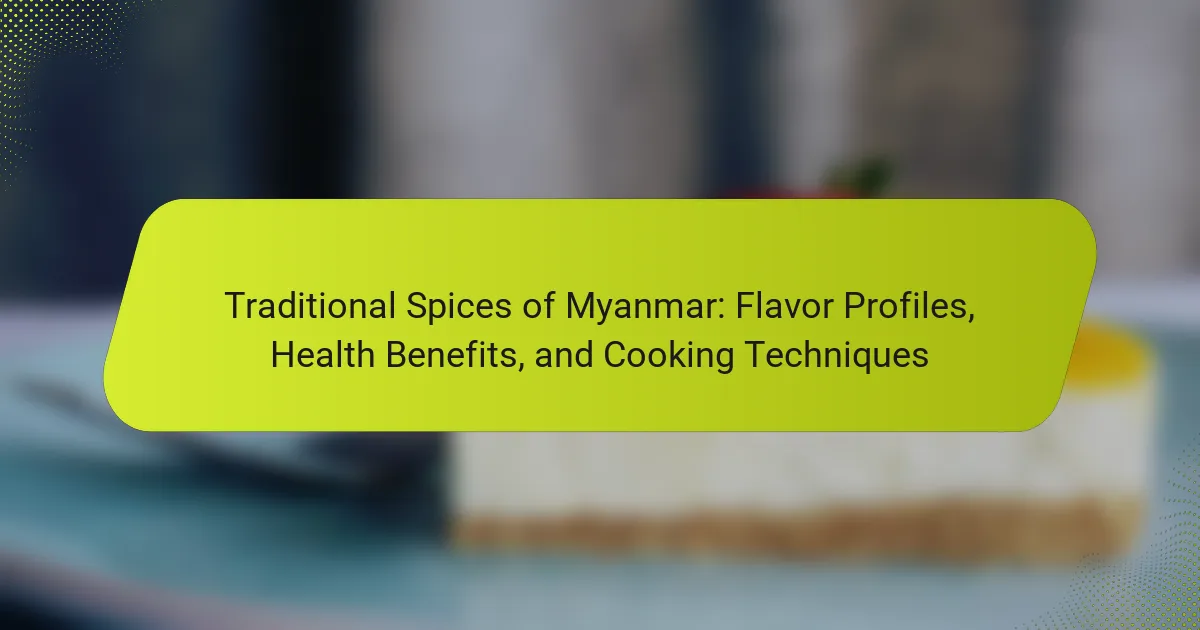Traditional spices of Myanmar, including turmeric, ginger, garlic, and chili, play a crucial role in the country’s culinary landscape. These spices are valued not only for their unique flavor profiles but also for their health benefits. Various cooking techniques, such as sautéing, boiling, steaming, fermentation, and grilling, are employed to enhance the flavors and nutritional value of dishes. Best practices for using these spices include proper storage, accurate measurement, and mindful timing during cooking to maximize their impact. Understanding the characteristics and applications of each spice is essential for achieving authentic Burmese cuisine.

What are Traditional Spices of Myanmar?
Traditional spices of Myanmar include turmeric, ginger, garlic, and chili. Turmeric is often used for its vibrant color and health benefits. Ginger adds warmth and depth to dishes. Garlic enhances flavor and aroma in many recipes. Chili provides heat and is essential in Burmese cuisine. These spices contribute to the unique flavor profiles found in Myanmar’s culinary traditions. Their usage reflects the cultural significance of spices in local cooking practices.
How do Traditional Spices contribute to Myanmar’s culinary identity?
Traditional spices are essential to Myanmar’s culinary identity. They provide unique flavors that define local dishes. Common spices include turmeric, ginger, and chili. These spices enhance the taste and aroma of traditional recipes. For example, turmeric is a key ingredient in curries and rice dishes. Ginger adds warmth and depth to soups and salads. Chili peppers contribute heat and vibrancy to various meals. The use of these spices reflects Myanmar’s cultural heritage and regional diversity. Historical trade routes introduced many spices, enriching local cuisine. Overall, traditional spices shape the flavors and culinary practices in Myanmar.
What are the most commonly used Traditional Spices in Myanmar?
The most commonly used traditional spices in Myanmar include turmeric, chili, ginger, garlic, and coriander. Turmeric is often used for its vibrant color and health benefits. Chili adds heat and flavor to many dishes. Ginger is valued for its aromatic qualities and medicinal properties. Garlic enhances the taste of various recipes. Coriander is used both as a spice and garnish, providing a fresh flavor. These spices are integral to Myanmar’s culinary identity, reflecting local agricultural practices and cultural preferences.
How are Traditional Spices integrated into everyday cooking in Myanmar?
Traditional spices are integral to everyday cooking in Myanmar. They enhance the flavor of various dishes. Common spices include turmeric, ginger, and chili. These spices are used in curries, soups, and salads. Turmeric adds color and health benefits. Ginger provides warmth and depth to flavors. Chili contributes heat and spice to meals. Locals often blend these spices in pastes for cooking. This practice reflects Myanmar’s rich culinary heritage.
What are the unique flavor profiles of Traditional Spices in Myanmar?
Traditional spices in Myanmar exhibit unique flavor profiles characterized by bold, aromatic, and complex tastes. Key spices include turmeric, known for its earthy and slightly bitter flavor. Ginger offers a warm and spicy note, while garlic provides a pungent and savory essence. Lemongrass contributes a citrusy brightness, enhancing dishes with its fresh aroma. Chili peppers add heat and depth, varying from mild to intensely spicy. These spices are often combined in various ways, creating layers of flavor in traditional Myanmar cuisine. For instance, the use of fish sauce introduces a salty umami element, enriching the overall taste experience. Each spice plays a vital role in defining the culinary identity of Myanmar, making its cuisine distinct and flavorful.
How do different spices enhance the taste of Myanmar dishes?
Different spices significantly enhance the taste of Myanmar dishes by adding depth and complexity. Spices like turmeric provide earthiness, while chili adds heat. Coriander seeds contribute citrus notes, balancing flavors. Garlic and ginger introduce aromatic qualities that elevate dishes. These spices create a harmonious blend that is essential in Myanmar cuisine. Historical usage of these spices dates back centuries, showcasing their integral role. The combination of spices also reflects regional diversity, influencing local recipes. Overall, spices are vital for achieving the distinctive taste of Myanmar dishes.
What are the contrasting flavor notes found in Myanmar spices?
Myanmar spices exhibit contrasting flavor notes such as heat, sweetness, sourness, and earthiness. For example, chili provides heat, while palm sugar adds sweetness. Tamarind introduces a tangy sourness, balancing other flavors. Turmeric contributes an earthy note, enhancing depth. These diverse flavors create a complex profile in traditional dishes. The combination of these contrasting notes is essential in Myanmar cuisine, making it vibrant and unique.
What health benefits do Traditional Spices of Myanmar offer?
Traditional spices of Myanmar offer various health benefits. Turmeric, a common spice, has anti-inflammatory properties. It contains curcumin, which may help reduce chronic inflammation. Ginger, another prevalent spice, aids digestion and can alleviate nausea. Studies show that ginger may also have anti-inflammatory effects. Garlic, used widely in Myanmar cuisine, is known to boost immune function. It contains compounds that can enhance cardiovascular health. Additionally, chili peppers, rich in capsaicin, may promote metabolism and weight loss. These spices contribute to overall well-being through their unique properties.
Which Traditional Spices are known for their medicinal properties?
Turmeric, ginger, and garlic are traditional spices known for their medicinal properties. Turmeric contains curcumin, which has anti-inflammatory and antioxidant effects. Ginger is recognized for its ability to alleviate nausea and digestive issues. Garlic is known to boost the immune system and lower blood pressure. These spices have been used in traditional medicine for centuries. Their health benefits are supported by various studies. For instance, curcumin’s effects are documented in the Journal of Medicinal Food. Ginger’s efficacy in treating nausea is noted in the Journal of Pain and Symptom Management. Garlic’s health benefits are highlighted in the American Journal of Clinical Nutrition.
How can Traditional Spices contribute to overall wellness?
Traditional spices can contribute to overall wellness through their various health benefits. Many traditional spices possess anti-inflammatory properties. For example, turmeric contains curcumin, which is known to reduce inflammation and improve joint health. Ginger is another spice that aids digestion and alleviates nausea. Cinnamon can help regulate blood sugar levels, making it beneficial for individuals with diabetes. Additionally, spices like garlic have antimicrobial properties that can boost the immune system. Research shows that the antioxidants in spices can combat oxidative stress, promoting heart health. Overall, incorporating traditional spices into the diet enhances nutritional intake and supports overall health.

What cooking techniques are used with Traditional Spices in Myanmar?
Traditional spices in Myanmar are used with various cooking techniques, including sautéing, boiling, and steaming. Sautéing is common for enhancing flavors by briefly frying spices in oil. Boiling is often used for soups and broths, allowing spices to infuse their essence into the liquid. Steaming preserves the spices’ flavors and nutrients, particularly in vegetable dishes. Fermentation is another technique that utilizes spices to create unique flavors in traditional foods. Grilling is also popular, where spices are applied to meats before cooking. Each of these techniques showcases the versatility of Myanmar’s traditional spices in culinary practices.
How do traditional cooking methods influence the use of spices?
Traditional cooking methods significantly influence the use of spices by determining their application and extraction of flavors. Techniques such as roasting, grinding, and simmering enhance the aromatic properties of spices. For instance, roasting spices before use can intensify their flavors and release essential oils. In Myanmar, traditional methods often involve slow cooking, allowing spices to meld with other ingredients. This method creates a deeper flavor profile in dishes. Historical practices show that the careful selection and preparation of spices have been integral to Myanmar’s culinary identity. Consequently, traditional cooking methods not only utilize spices but also elevate their impact on overall taste and health benefits.
What are the key techniques for incorporating spices into dishes?
Key techniques for incorporating spices into dishes include toasting, grinding, and blending. Toasting spices enhances their flavor by releasing essential oils. This technique is common in many cuisines, including Myanmar. Grinding spices fresh maximizes their potency and aroma. Whole spices maintain flavor longer than pre-ground ones. Blending spices creates unique flavor profiles. This technique is essential in traditional Myanmar dishes. Additionally, adding spices at different cooking stages alters their impact. Early addition infuses dishes, while late addition preserves brightness. Each technique contributes to the overall depth of flavor in dishes.
How do cooking times and methods affect the flavor of spices?
Cooking times and methods significantly influence the flavor of spices. Longer cooking times often lead to a deeper, more integrated flavor. For example, spices like cumin and coriander release essential oils when heated, enhancing their aroma and taste. Conversely, quick cooking methods may preserve the fresh, vibrant qualities of spices. Techniques such as toasting spices can intensify their flavors, while boiling might dilute them. The Maillard reaction, occurring during prolonged cooking, adds complexity to spice flavors. Research indicates that heat can alter the chemical composition of spices, impacting their flavor profile. For instance, a study by the University of California found that roasting spices can enhance their flavor compounds.
What role do spices play in Myanmar’s cultural practices?
Spices play a significant role in Myanmar’s cultural practices. They are integral to traditional cuisine, enhancing flavor and aroma. Spices are used in ceremonial dishes during festivals and religious events. They symbolize hospitality and are often offered to guests. The use of spices reflects Myanmar’s diverse ethnic heritage. Each ethnic group incorporates unique spices into their culinary traditions. For example, turmeric and ginger are common in many dishes. Spices also have medicinal properties, contributing to health and wellness practices. The cultural significance of spices is evident in local markets and cooking methods.
How are spices used in traditional celebrations and rituals?
Spices are integral to traditional celebrations and rituals in Myanmar. They enhance the flavors of ceremonial dishes. For example, turmeric is often used in religious offerings. It symbolizes purity and auspiciousness. Additionally, chili is featured in festive meals to represent joy and prosperity. Spices also play a role in traditional medicine during celebrations. They are believed to bring good health and ward off evil spirits. The use of spices varies by region and occasion, reflecting local customs. Overall, spices contribute both flavor and cultural significance to Myanmar’s celebrations.
What significance do spices hold in Myanmar’s history and heritage?
Spices are significant in Myanmar’s history and heritage as they have influenced trade, cuisine, and cultural practices. Historically, Myanmar was a key player in the spice trade, connecting Southeast Asia with India and China. This trade brought wealth and cultural exchange, enriching Myanmar’s culinary diversity. Spices like turmeric, ginger, and chili are integral to traditional dishes, reflecting the country’s agricultural practices. Moreover, spices are often linked to traditional medicine in Myanmar, showcasing their importance beyond just flavor. The use of spices in rituals and festivals also highlights their cultural significance. Overall, spices are deeply woven into the fabric of Myanmar’s identity and heritage.

What are the best practices for using Traditional Spices in cooking?
The best practices for using traditional spices in cooking include proper storage, appropriate measurement, and mindful timing. Store spices in airtight containers away from light and heat to preserve their potency. Measure spices accurately to maintain flavor balance in dishes. Add spices at different cooking stages; early for deeper flavors and later for freshness. Toasting spices can enhance their aroma and taste. Use fresh spices for maximum flavor impact. Experiment with combinations to discover unique flavor profiles. Understanding the specific characteristics of each spice can guide effective usage.
How can one effectively store and preserve Traditional Spices?
To effectively store and preserve traditional spices, keep them in airtight containers. Glass jars or metal tins are ideal for maintaining freshness. Store these containers in a cool, dark place away from direct sunlight. High temperatures and moisture can degrade spice quality. Use whole spices whenever possible, as they retain flavor longer than ground spices. Ground spices should be used within six months for optimal potency. Label containers with the date of purchase to track freshness. Regularly check for signs of spoilage, such as loss of aroma or color. Proper storage can extend the shelf life of spices for up to two years.
What tips are there for balancing flavors with spices in dishes?
To balance flavors with spices in dishes, start by understanding the primary flavor profiles of the spices used. Use complementary flavors to enhance the dish. For instance, pairing spicy ingredients with sweet or acidic components can create a harmonious balance. Gradually add spices to avoid overpowering the dish. Taste frequently during cooking to adjust the seasoning as needed. Consider the cooking method, as some spices release their flavors differently when simmered versus sautéed. Fresh herbs can also provide a bright contrast to robust spices. Lastly, remember that salt can amplify flavors, so use it judiciously to enhance the overall taste.
How can one experiment with Traditional Spices to create new recipes?
To experiment with traditional spices and create new recipes, start by understanding the flavor profiles of each spice. For example, turmeric offers an earthy flavor, while chili adds heat. Combine spices in varying ratios to discover unique blends. Use traditional spices in non-traditional dishes, such as adding cumin to a salad dressing. Incorporate spices into marinades for meats or vegetables to enhance flavor complexity. Adjust cooking methods, like roasting or sautéing, to bring out different spice notes. Document each experiment to track successful combinations. The culinary tradition of Myanmar showcases diverse spice usage, highlighting the potential for creativity.
Traditional spices of Myanmar, including turmeric, ginger, garlic, and chili, are essential to the country’s culinary identity, providing unique flavors and health benefits. This article explores the flavor profiles of these spices, their integration into everyday cooking, and their cultural significance in Myanmar’s traditions and rituals. It also covers best practices for using, storing, and experimenting with these spices to enhance dishes. Additionally, the health benefits associated with these traditional spices, such as anti-inflammatory properties and digestive support, are highlighted, reflecting their importance in both cuisine and wellness.
